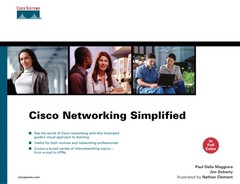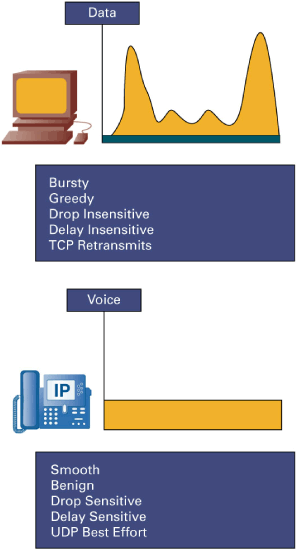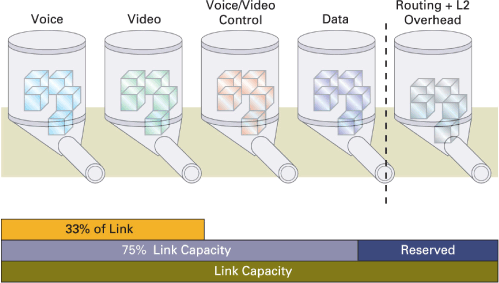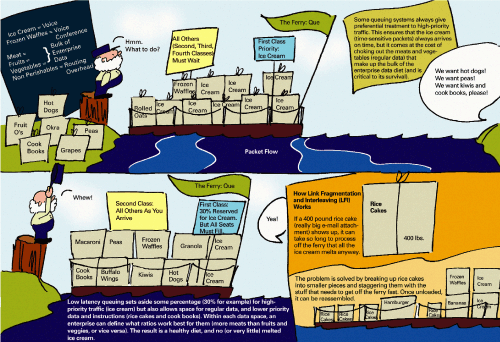Quality of service (QoS) is the enabler of the Internet Protocol (IP) network convergence trend. The fundamental concept that enables IP network convergence is the conversion or tunneling of other network technologies into Transmission Control Protocol/Internet Protocol (TCP/IP) across traditional data networks. With voice, it’s the conversion of traditional time-division multiplexing (TDM) voice streams into packetized voice packets. IP networks are built on shared bandwidth. Thus IP networks must have mechanisms that “simulate” the dedicated on-time delivery associated with traditional voice and video networks.
Moving voice, video, and other time-sensitive technologies onto traditional data networks requires that the streams be delivered on time with minimal loss and consistent delay. A delay or loss of packet in a voice stream, for example, causes a break or chop in the conversation. There is no need to retransmit a voice packet if it gets lost because that packet is only relevant at one point of time in the conversation.
Traditional data networks are less concerned with on-time delivery and loss. For example, although congestion slowing down a file download might be inconvenient and annoying, the file eventually downloads intact. The higher-layer protocols take care of making sure that all the bits transfer and that the bits end up as they were transmitted. Whether it takes 10 seconds or 10 hours for the file to transfer is irrelevant (although perhaps annoying) because the higher-layer protocols ensure the file arrives intact at the other end.
QoS is a collection of tools and practices that enable data networks to mark, prioritize, and schedule traffic. Each device on a network participates in QoS; otherwise, the quality of service varies throughout a network.
Elements of QoS include the following:
Network design—. You must design and build a network to handle the amount of data and time-sensitivity required for a company’s network convergence. All of the devices in the network must support their roles in the QoS process. For example, if a company wants to enable voice across its wide-area data network, the WAN topology must have enough bandwidth to handle the calls and existing data traffic. Additionally, the routers and WAN service provider must be able to participate in the marking, prioritization, and scheduling necessary to deliver on-time reliable voice quality.
Packet marking—. The first step in the QoS process is indicating which packets have higher importance than others. When a packet comes into the network, it is assigned a number that indicates its importance. In TCP/IP networks, this number is called the type of service (ToS), and it is a value from zero to seven (zero being the lowest and seven the highest priority).
Prioritization and queuing—. Traffic is prioritized according to the ToS setting in each packet or where the packet arrives from. Queuing is the mechanism in each device that enables the network to process higher-priority packets (such as important applications or voice traffic) before lower-priority packets. Just like the platinum frequent flyers at the airport, higher-priority packets get to jump ahead of lower-priority packets. Like a bouncer in a nightclub, if it sees too many low-priority packets in line, the router must throw out some of them to let the higher-priority packets through.
Scheduling—. After the packets are ordered by priority and processed by a network device (such as a router), they must be scheduled to go out a network interface. Interfaces with limited bandwidth (such as a WAN) might have more traffic waiting to be transmitted than there is bandwidth available. Traffic-shaping mechanisms act as air-traffic controllers at an airport in that they sort outbound traffic into priority order while also making sure the lower-priority traffic isn’t starved.
Link fragmentation and interleaving—. Networks have big packets and small packets. Video and file transfer are examples of big packets, and voice is an example of small packets. Fifteen voice packets might be the same size as one file-transfer packet. If 15 voice packets must wait for one file-transfer packet to traverse a slow WAN, it might be too late for the voice traffic to be useful. This concept is called delay, and the variation in delay that occurs is called jitter. Delay and jitter are the enemies of voice and video over data networks. Link fragmentation is the process of slicing one large packet into many smaller packets. Interleaving is the process of placing important traffic in between the less-important traffic. Therefore, voice packets continue to make it to their destination on time in between the fragments of the original file-transfer packet.
Bandwidth reservation—. Also called provisioning, this process reserves certain portions of limited bandwidth for high-priority traffic. That bandwidth is always there. If the amount of low-priority traffic exceeds the bandwidth available, the network does not use the reserved bandwidth and instead discards low-priority traffic. Bandwidth reservation is a necessary component for handling time-sensitive traffic.
The combination of QoS mechanisms and effective network design ensure the success of converging voice, video, and data onto the same network.







